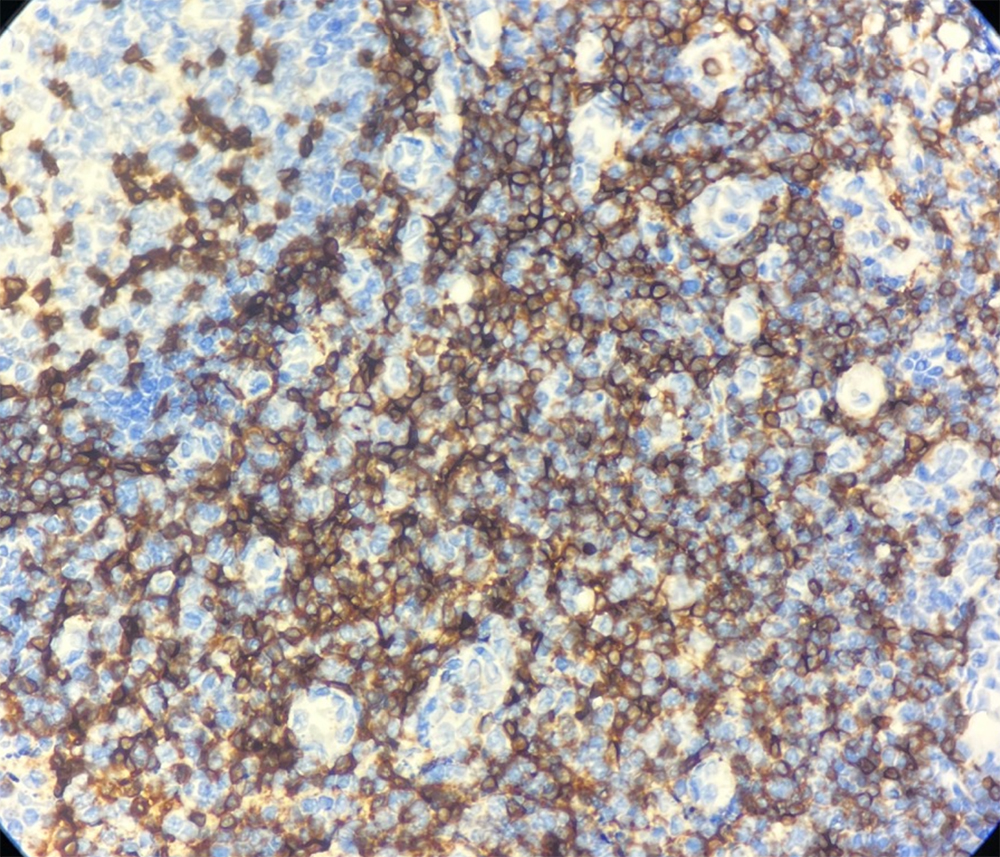
CD3 Antibody (DA024)
CD3 Antibody (DA024)
Recombinant monoclonal rabbit antibody
Description
CD3’s immunohistochemical detection locates the cytoplasmic component of CD3 protein. Anti-CD3 is considered to be a pan-T-cell marker and reacts with an antigen present at the surface and in the cytoplasm of T lymphocytes. Anti-CD3 is widely used for the identification of immature and mature T-cell malignancies.1-8 With a high specificity and low sensitivity, it is combined with CD45RO to improve its diagnostic accuracy.
References
1. Denning SM, et al. Activation of human thymocytes via CD3 and CD2 molecules. In: McMichael AJ, et al. eds. Leucocyte Typing III, White Cell Differentiation Antigens. Oxford-New York-Tokyo. Oxford University Press. 1987; 144-7.
2. Beverley PC, et al. Distinctive functional characteristics of human "T" lymphocytes defined by E rosetting or a monoclonal anti-T cell antibody. Eur J Immunol. 1981; 11:329-34.
3. Clevers H, et al. The transmembrane orientation of the epsilon chain of the TcR/CD3 complex. Eur J Immunol. 1988; 18:705-10.
4. Campana D, et al. The cytoplasmic expression of CD3 antigens in normal and malignant cells of the T lymphoid lineage. J Immunol. 1987; 138:648-55.
5. Hedvat CV, et al. Application of tissue microarray technology to the study of non-Hodgkin's and Hodgkin's lymphoma. Hum Pathol. 2002; 33:968-74.
6. Karube K, et al. Non-B, non-T neoplasms with lymphoblast morphology: further clarification and classification. Am J Surg Pathol. 2003; 27:1366-74.
7. Dogan A, et al. Micronodular T-cell/histiocyte-rich large B-cell lymphoma of the spleen: histology, immunophenotype, and differential diagnosis. Am J Surg Pathol. 2003; 27:903-11.
8. Axdorph U, et al. T-cell-rich B-cell lymphoma - diagnostic and therapeutic aspects. APMIS. 2002; 110:379-90.
2. Beverley PC, et al. Distinctive functional characteristics of human "T" lymphocytes defined by E rosetting or a monoclonal anti-T cell antibody. Eur J Immunol. 1981; 11:329-34.
3. Clevers H, et al. The transmembrane orientation of the epsilon chain of the TcR/CD3 complex. Eur J Immunol. 1988; 18:705-10.
4. Campana D, et al. The cytoplasmic expression of CD3 antigens in normal and malignant cells of the T lymphoid lineage. J Immunol. 1987; 138:648-55.
5. Hedvat CV, et al. Application of tissue microarray technology to the study of non-Hodgkin's and Hodgkin's lymphoma. Hum Pathol. 2002; 33:968-74.
6. Karube K, et al. Non-B, non-T neoplasms with lymphoblast morphology: further clarification and classification. Am J Surg Pathol. 2003; 27:1366-74.
7. Dogan A, et al. Micronodular T-cell/histiocyte-rich large B-cell lymphoma of the spleen: histology, immunophenotype, and differential diagnosis. Am J Surg Pathol. 2003; 27:903-11.
8. Axdorph U, et al. T-cell-rich B-cell lymphoma - diagnostic and therapeutic aspects. APMIS. 2002; 110:379-90.
Specifications
Application:
IHC (FFPE)
Host:
Rabbit
Subclass:
IgG
Immunogen:
Synthetic peptide of human CD3
Cellular location:
Cell membrane
Control:
Tonsil
Order information
| RMA1A005 | Concentrate | IVD(R) |
| RMA1A005 | 10 ml Ready to use | IVD(R) |
| RMA1A005 | 6 ml Ready to use | IVD(R) |
| RMA1A005 | 3 ml Ready to use | IVD(R) |


